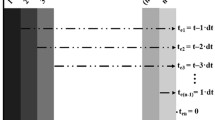Summary
Because of the wide inter individual variability between patients and their marked differences in drug response, one of the major issues that arises is adapting the therapy in question to the particular patient. In hospital, it is possible to vary the conditions of intravenous (i.v.) drug delivery by means of short infusions repeated at certain intervals. In this study, review of this process has been presented, and a therapeutic method described. It essentially consists of two stages. The first concerns the time of the first infusion, and the course of drug elimination: from two analyses of the drug concentrations in the blood made at two different times, the pharmacokinetic parameters of the patient are determined. Stage 2 consists of repeated short infusions and the therapy is adapted to the particular patient by varying the conditions involved. Thus, either the amount of the dose based on the rate of infusion or the time interval between the repeated infusions are varied. In order to reach a general solution, master curves are built by using dimensionless numbers as co-ordinates, such as time expressed in terms of the half-lifet 0.5 of the drug, and the drug concentration at the peaks defined as a fraction of the first unchanged peak concentration.
Similar content being viewed by others
References
Vergnaud J.M. and Rosea I.D. (2005): Assessing bioavailability of drug delivery systems. CRC Press, Taylor & Francis Group: Boca Raton, FL, USA.
Smith D.A., Van de Waterbeemd H. and Walker D.K. (2001): Pharmacokinetics and metabolism in drug design. Methods and principles in medicinal chemistry, Wiley-VCH: Weinheim, Germany, vol. 12, ch. 2.
Dictionnaire Vidal, Vidal Publ. (2005): 2 rue Béranger, 75140 Paris, cedex 03, France.
Campoli-Richards D.M., Monk J.P., Price A., Benfield P., Todd P.A and Ward A. (1988): Ciprofloxacin: a review of its antibacterial activity, pharmacokinetic properties and therapeutic use. Drug evaluation. Drugs, 35, 373–447.
Breilh D., Saux M.C., Maire P., Vergnaud J.M. and Jelliffe R.W. (2001): Mixed pharmacokinetic population study and diffusion model to describe ciprofloxacin lung concentrations. Comput. Biol. Med., 31,147–155.
Wise R. and Donovan, I. (1987): Tissue penetration and metabolism of ciprofloxacin. Am. J. Med., 82 (Suppl. 4 A), 103–107.
Fabre D., Bressole F., Gomeni R., Arich C., Lemesle F., Beziau H. and Galtier M. (1991): Steady-state pharmacokinetics of ciprofloxacin in plasma from patients with nosocomial pneumonia: penetration of the bronchial mucosa. Antimicrob. Agents Chemother., 35,2521–2525.
Smith M.J., White L.O., Bourgee H., Willis J., Hodson M.E. and Batten J.C.(1986): Pharmacokinetics and sputum penetration of ciprofloxacin in patients with cystic fibrosis. Antimicrob. Agents Chemother., 30, 614–616.
Author information
Authors and Affiliations
Corresponding author
Rights and permissions
About this article
Cite this article
Rosca, I.D., Vergnaud, J.M. Adapting therapy with repeated short-infusions to inter individual variability between patients. Eur. J. Drug Metabol. Pharmacokinet. 32, 87–99 (2007). https://doi.org/10.1007/BF03190997
Received:
Issue Date:
DOI: https://doi.org/10.1007/BF03190997




